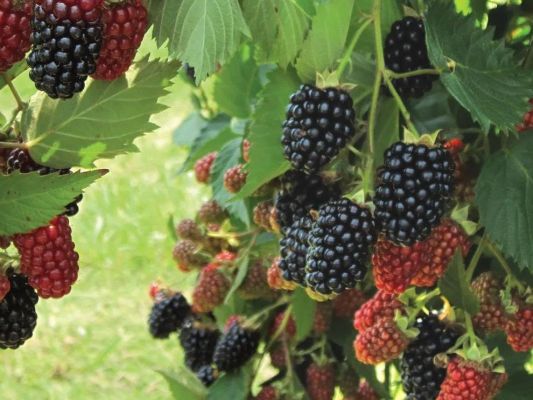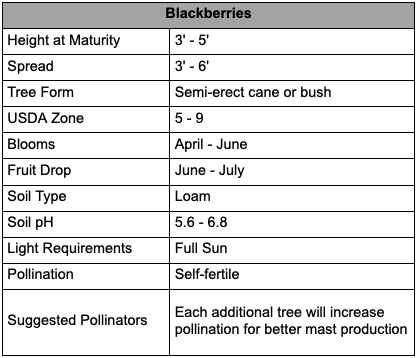Alachua, FL (April 24, 2025) – Discussions about planting to increase wildlife nutrition usually involve food plots or hard mast trees. Adding soft mast species to the list increases the diversity of available food and can also widen the window of availability. In the case of particular species, like blackberries, it can also add cover for protection from predators and the elements.
That is why Chestnut Hill Outdoors offers five varieties of blackberries, each with slightly different growth characteristics. Orchardists can choose the one best suited to their site or plant several to widen the window of available nutrition. In addition to providing food and cover for wildlife, they are also ideal for a wide range of culinary uses, from fresh eating to jams, jellies, preserves, and pies.
The Natchez Blackberry is a large, sweet, thornless variety that grows in semi-erect canes, forming more of a bush than other varieties. It ripens in June, making it one of the earliest sources of sweet nutrition for food plots, and requires only 300 chill hours. The Freedom Blackberry is a thornless, semi-erect variety known for producing an impressive yield of large, firm, glossy berries requiring only 200 chill hours.

The Traveler Blackberry has an erect growth habit, allowing it to stand upright without needing extensive support. However, it can still benefit from light trellising for better fruit production and maintenance. It is a low-chill variety, requiring only 300–400 chill hours, making it suitable for warmer climates in USDA zones 5–9. The plant is relatively low-maintenance and resistant to common blackberry diseases such as rust and mold.

The Ouachita Blackberry is a vibrant, sweet, thornless, low-chill variety with erect, sturdy canes that grow neatly in rows. It is ideal for forming a natural, fruitful hedge in USDA zones 6–9. Lastly, the Triple Crown blackberry offers an extended harvest period over several weeks in mid to late summer, usually from July to August.
Climate is always a concern for orchardists, so selecting plant varieties best suited to the USDA plant hardiness zones in which they will be established is essential. This system is often used as a guideline to avoid areas that are too cold or cold for too long. However, some cold is necessary for soft mast shrubs, particularly blackberries.
“Chill hours” refer to the duration a fruit tree is exposed to temperatures between 32 and 45 degrees F during its dormant stage. These chill hours help the plants break dormancy, and an insufficient amount can result in poor fruit quality. That is why Chestnut Hill Outdoors offers several varieties of low-chill blackberries for warmer climates in southern states. They are also suited to cooler climates up to USDA Zone 5.

About Chestnut Hill Outdoors
Chestnut Hill is the best place for you to purchase your food plot and deer attractant plants because they offer a large selection, their plants are specifically bred to attract deer, and they offer customers different-sized plants at different levels of growth. To ensure you receive the maximum benefit from their products, they also provide sound advice and instruction on proper planting and care. For more on Chestnut Hill Outdoors products and how to care for them, visit ChestnutHillOutdoors.com, or call (855) 386-7826.
For more information, please visit
WWW.CHESTNUTHILLOUTDOORS.COM
Read the full article here




